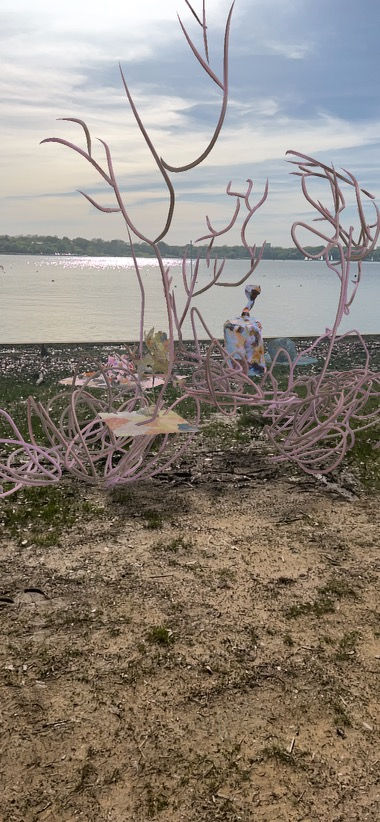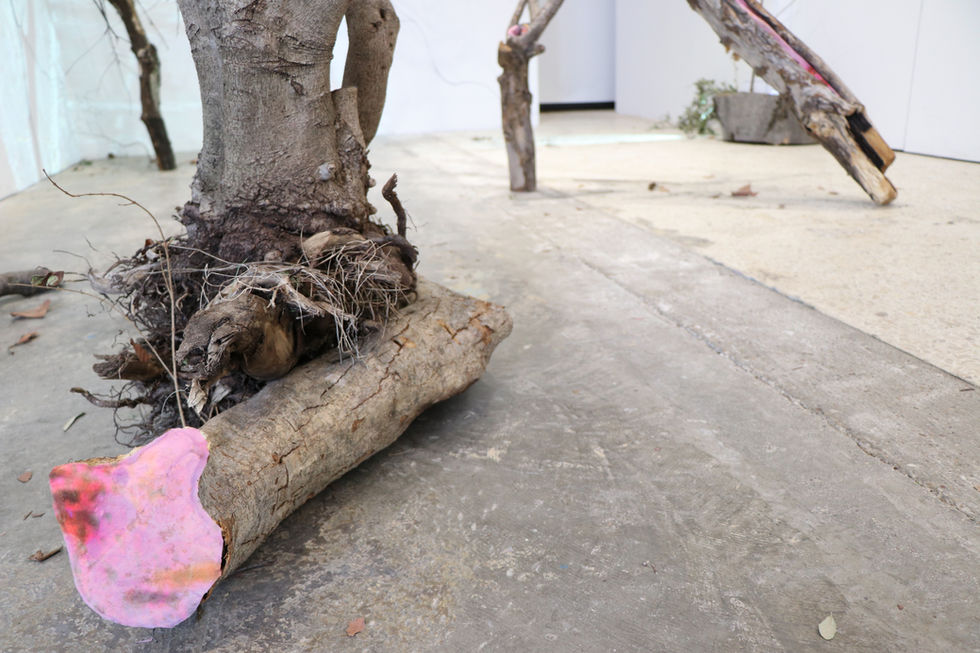
"Eco-Interoception" | Pollock Gallery, March 25-April 15 2023
Eco-Interoception is the process through which I've better understood my body – by learning about the earth's. Below is the poem that served as the wall text for my thesis exhibition, Eco-Interoception, if you would like to read my full thesis that accompanies the exhibition, you can find that here.
Intro

Process

Urban Pedestrians

Trees

Fungi

Slime Molds

Reflection

I make widening circles, at first, starting small.
And slowly, I see things in my life that I’ve seen before, but with
weeks of memory and perspective layered upon each
new circle. They continuously rotate until their layers
bring someone or something into focus.
For a moment, I’m humbled to believe
I’ve gleaned some inkling of
divine understanding, and then it’s gone.
I have become a series of ADHD loops,
leading me somewhere,
feeling at the time obsessive and insular, entangling me
inwards, to see the connectivity of all things.
My brain needs this interconnectivity
between objects, peoples, concepts, materials–
for a single moment of clarity.
How can I untangle all of this...weave it all together?
First, I was fixated on smartphones, and
their impact on human body movement,
a sense of self, and the ability to connect.
But that fizzled in anxiety. It didn’t have roots or dirt.
I used to be entranced with the dance of urban pedestrians
on a concentrated street corner.
But, humans began to bore me
Branching fractals in wintering trees
offered themselves to my imagination,
luring me from above as I walked.
A branching fractal is so appealing, because it is in us.
(Us as in humans, but other species too).
Blood vessels. Muscles. Neural pathways.
Our eyes scan in fractals...my obsession is nothing
but an evolutionary-approved stress-relief tactic.
A tree in winter is what the brain looks like in depression.
A tree in spring is what the brain looks like when it's "healthy"–
synapses flourishing and firing.
Do you think I could eat a fractal?
And then, fungi entreated me,
an often overlooked or feared species.
They gestured to me from below as I walked.
Mycelium (the root systems of mushrooms) finally gave me
a visual representation of how I imagine the network of my brain.
Thin, yet strong fibers making connections across vast distances.
Fungi led me outside of myself only to realize an entangled and far-reaching pathway that guided me back inwards.
To see that what was around me (in nature) was inside me.
To see my body as the earth’s.
Now I move towards the oldest eukaryotes, protists...
more specifically, to slime molds.
They are hard to categorize –
interspecies, transpecies, multispecies?
They do not dawdle, distracted by looped thoughts, instead
Finding the most efficient pathways forward.
I wanted to partner with them to make a map for the exhibition,
but they didn’t agree.
That’s the thing with working with other species:
They do what they want.
The last thing I have to tell you:
Don’t be fooled.
There is nothing to understand,
no right path to follow.
This is simply my elaborate
coping mechanism.
The only question I have for you is:
What's yours?

"Eco-Interoception" | Exhibition Brochure
“We come from the earth and we return to it, and so we live in agriculture as we live in flesh. While we live our bodies are moving particles of the earth, joined inextricably both to the soil and to the bodies of other living creatures.” —Wendell Berry, “The Body and The Earth”
Sara and I shared studio space during our senior year of college. On the morning of our first critique, I found Sara’s section totally enclosed in an assemblage of string, reflective cellophane, and large sheets of crumpled paper. I stuck my head inside this pseudo fort; a mirror sat on the ground, swags of paper hung from the ceiling, and numerous aerial photos showing people moving through space adorned the walls. Sara arrived, and we laughed about building pillow forts in our childhood homes. That’s what I made, she said, a space to disconnect, then connect. To look up from your phone, to look inside, to look at your neighbor. To feel your body take up space.
Critique and vulnerability are not comfortable at twenty-two—what significance do your materials and process hold? Why is there paper hanging from the ceiling, and why is the tape visible? You need to be more intentional with your decisions. Afterward, Sara left the room. I followed; we walked to a nearby playground and sat on the swings. I can’t think straight. I can’t get outside my head. I feel nauseous. It must be side effects from my new medicine. It must be stress. The wind blew wood chips over our shoes, and a leaf fell from the bare branches overhead, descending slowly through the chill Virginia air.
Eco-Interoception is an advanced iteration of the pseudo fort—a space to disconnect from distraction and connect to the self. The installation, which includes works on paper, VR and video components, and sculptures made from a combination of found and fine art materials, manifests a growing mind-body connection, utilizing ecology as both a metaphor for and a mode of neurological healing. Foraged branches hang from the ceiling and reach toward one another, studio-grown mushrooms sit in dishes and on pedestals, and commercially-printed textiles are interspersed throughout. Each element visualizes the cycle of decay and growth that exists in both nature and the psyche. The fractal patterns present in the branches and fungi growth mimic neural pathways in the brain during neurogenesis; as organic life generates from decomposition, so the brain heals from trauma or disease. Eco-Interoception mandates that its viewers participate by confronting these parallels as they wander between tangled branches and observe the mycelium (or mushrooms’ root system) and thus, their own cycles of decay and regeneration. In this way, the work encourages connection to the self, one another, and the earth. It creates a space where this is possible—a space that merges the organic and manmade, the visible and ephemeral, the internal and external.
Sara’s eco-art practice is highly research-driven, and her particular interest in mushroom ecology developed after beginning a Ketamine treatment regimen for depression. Throughout the process, she gained a deep understanding of neurological healing, where connections form and reform in the brain. She turns to the natural world, which consistently and visibly cycles through death and rebirth, to harness this process. Mushrooms are a literal manifestation of growth from decay as their mycelium form and reform connections to the earth and to the “self” of the organism. There is a larger metaphor here as well: mycelium, tree roots, mind-body connections, and neurological healing fuse in Eco-Interoception to illustrate both the precariousness and decay of our planet and the opportunity we have to participate in its healing.
Textiles are another crucial aspect of Eco-Interoception. The branches placed and hung throughout the installation mimic root systems, which in turn mimics psychic healing. But the branches themselves are fractured—full of holes, cracks, and points of weakness and decay. Sara hand-places, inserts, or attaches fabrics and kozo paper in these areas, creating a patchwork that merges manmade and natural materials. Actions of mending, stitching, and sewing are visible, and the presence of these textiles suggests yet another method of connection and reconnection, this time with an emphasis on the interpersonal. These cycles of growth and decay—neurogenesis, mushroom ecology, root systems—are often supported by something external. Our healing accelerates when we join forces and strengthen our connections. So too, does the healing of the planet. This is the utopia that Eco-Interoception suggests: our bodies, minds, and earth are one, and we must strive to increase our degree of interconnectedness on every register.
That day in Virginia, we went outside. We sat with ourselves, together. We looked at each other, and we looked up. Branches silhouetted against the gray sky, fractaled and split into countless pathways, becoming new at each juncture—each knobby joint and fragile length evidence and assurance of growth. We took deep breaths with the wind. We felt our bodies in space.
–McKenna Quatro Johnson
MA Candidate in Art History, The Institute of Fine Arts NYU






















